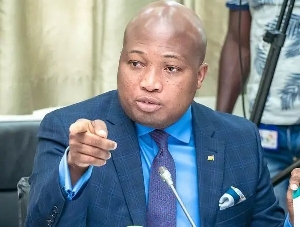Dr. James Watson, the disgraced septuagenarian U.S. scientist and DNA pioneer, insulted black people everywhere when he said earlier this month that Black people were inferior to White people in all facets of human physiology and endeavor. While Dr. Watson’s blunt pillorying came as a surprise to many, I was not shocked at all: Black people deal with hundreds of Watsons on a daily basis, and whites, unquestionably because of the “advantage” of their skin color, especially in Europe, Australia and North America, have always had an easier life wherever they find themselves, purporting that such societal benefits translated to superior intelligence, capabilities and ingeniousness, as compared to black people.
I am constantly reminded by what the highly respected Tom Brokaw, the ex-anchor of NBC Nightly News, a nationally televised news broadcast in the U.S.A., said his last day as host of the show. His voice laden with emotion, Mr. Brokaw uttered some very somber words, iterating that for the 21 years that he served as anchor, not a day went by that he did not consider the fact that had the shade of his skin been a tad darker, he may not have gotten the job as anchor of NBC Nightly News!
A few years ago, a professor told my colleagues and me in an Ethics and Diversity class that he knew a white military officer who once asked a fellow white officer how the latter felt serving under Colin Powell, the celebrated black former military general and Chairman of the Joint Chiefs of Staff of the U.S. Armed Forces. That Colin Powell was qualified to head all branches of the U.S. Armed Forces was not the point of contention between the two white officers, but the color of the general’s skin! This perverse and bigoted attitude by many white people is nothing new to blacks in the U.S.A. I shudder to even discuss the percentage of able-bodied black men regularly thrown into U.S. jails, some for whom justice was never served!
Now that Dr. Watson has shared with the rest of the world his spurious and scientifically bereft ideas about black people ? Dr. Watson must be lucky the “great burden” has not landed him in a sanitarium up to now ? I consider it my duty to remind/inform black people everywhere that the forays into the sciences and other disciplines by their progenitors, even amidst limited opportunities due to the color of their skin, resulted in some of the greatest technological breakthroughs known to man ? not only inventions chalked in the 19th and 20th centuries, but also the ones achieved in contemporary times. All black people everywhere thus owe it a duty to the next generation of black children to make sure black achievements in science, technology, medicine, among other fields of human endeavor, are espoused accurately, to counter the misinformation and stereotyping about blacks that have become pervasive in the white-controlled media outlets in the last several decades.
James Kessler, in his highly acclaimed book, “Distinguished African American Scientists of the 20th Century,” in illuminating the achievements of many notable blacks, enjoins black parents and leaders to instill in young blacks the essence of achievement, not only in sports, music and movies, but also “in such diverse fields as anthropology and physics, mathematics and endocrinology.” Kessler continues: “Young children, both Black and White, should remember that many of the people mentioned in this book grew up under very difficult economic constraints, social injustices and racial prejudices, with very little encouragement from the outside. But they were individuals with enormous determination, sterling character, and sense of self-worth who struggled under intolerable conditions. These men and women devoted themselves to serious study and intellectual pursuits. They knew there was racism and prejudice in the society in which they lived, but they did not use this as an excuse for keeping away from books or building their own grammar and vocabulary.” I wish to discuss a few black men and women, who, through their relentless efforts in the midst of the worst prejudices of their time, jettisoned every horrific label and made it to the top of their professions.
George Washington Carver: Born in 1864 in Missouri toward the end of the U.S. Civil War, Carver and his mother were kidnapped by Confederate soldiers while he was just an infant. Although he was later found by his father, the young Carver would never see his mother again. Carver started formal education at 12, but since all schools were segregated at the time, he was forced to move to Newton County, Missouri, where he supported his education by working as a farm hand. At 30, Carver enrolled as the only black student at Simpson College in Iowa. Determined to study science, Carver transferred to Iowa Agricultural College (now Iowa State University) in 1891, where he earned a B.S. in 1894 and an M.S. in Bacterial Botany and Agriculture in 1897. Carver later became the first black professor at Iowa Agricultural College. Carver moved to Alabama in 1897, becoming the Director of Tuskegee Normal and Industrial College. It was at Tuskegee that Carver discovered more than three hundred uses for peanuts, and several hundred more uses for soybeans, pecans and sweet potatoes. Single-handedly, Carver’s ideas transformed southern United States from a region that depended on a single crop (cotton) to one that embraced many different crops, leading to the revival of the South’s economy after the Civil War. In 1939, Carver fittingly received the Roosevelt medal for transforming agriculture in the South. And in 1943, Carver was honored with a national monument, the first such designation for a black man in the U.S.A.
Charles Drew: Because Drew was an exceptional athlete, most people assumed he would grow up to pursue a career in sports. Although Drew attended Amherst College on a sports scholarship, he was unable to raise enough money to go to medical school upon graduation in 1926. He therefore had to take up teaching at Morgan State University, Maryland, to raise enough money to enroll at the University Medical School in Canada. After medical school, Drew developed an interest in blood transfusions. While on a two-year Rockefeller Fellowship at Columbia University Presbyterian Hospital in New York, Drew made a remarkable discovery! At the time, blood could be stored for no more than 7 days, but Drew discovered that using plasma (blood from which cells have been removed) could prolong the viability of blood. Both revolutionary and timely, Drew’s innovation would help save the lives of thousands of Allied soldiers during the Second World War.
Lloyd Noel Ferguson: Born in 1918, Ferguson showed signs he was a gifted boy when, while in high school, he developed handy products such as moth repellent, silver polish and spot remover, products that he sold for cash. He later enrolled at the University of California, Berkeley, earning a B.S. in Chemistry in 1940 and a Ph.D. in 1943. While at Berkeley, he worked with a team to develop a hemoglobin type of compound that could both gain and lose oxygen. Ferguson’s research eventually led to the refining of this compound, which is now commonly used as a source of oxygen in submarines.
The Tuskegee Airmen: Because of prejudice and discrimination from their white counterparts, an all-Black aviation squadron was formed to fight the Germans during World War II. It was an all-volunteer group that thrived on discipline and dedication. The Tuskegee Airmen’s fighting force, named the 332nd Fighter Group, distinguished itself by not losing a single bomber during more than 200 combat missions and air raids over enemy territory, a record that still stands today! I hope you are reading this, Dr. Watson!! As a result of the bravery, dedication and adroitness of the Tuskegee Airmen, President Truman had no choice but to issue an executive order directing equal treatment for all in the U.S. military, which in time led to the end of racial bias in the U.S. Armed Forces. Today, there is a historic site dedicated to the valor of these black aviators.
George Carruthers: Born in Ohio in 1939, Carruthers grew up in Chicago, and by age 10 had built a telescope. Carruthers obtained a B.S. in Aeronautical Engineering from the University of Illinois in 1961, going on to earn an M.S. in Nuclear Engineering in 1962 and a Ph.D. in Aeronautical and Astronautical Engineering in 1964. Carruthers is recognized for his work on ultraviolet light: He led a team that invented the far ultraviolet camera spectrograph. Carruthers also developed the first moon-based space observatory, an ultraviolet camera flown to the moon in 1972 by the Apollo 16 crew. He has further served as a principal investigator for many NASA- and U.S. Dept. of Defense-sponsored space equipment, which includes a 1986 equipment that captured a special image of Comet Halley.
Patricia Bath: Born in New York in 1942, Bath excelled academically, winning several awards while still in high school. At the tender age of 16, Bath was chosen to participate in a summer program offered by the National Science Foundation at Yeshiva University. And while at Yeshiva, the young Bath developed a mathematical formula for predicting cancer cell growth! Bath finished medical school at Howard University, Washington, D.C., in 1968 and served as an Ophthalmology Fellow at Columbia University in 1969 and 1970. Finding that blacks had twice as many ophthalmic problems as whites due to lack of access to good eye care, Bath established a new discipline called Community Ophthalmology, a field now practiced worldwide. In 1976, Bath co-founded the American Institute for the Prevention of Blindness, an organization that focuses on protecting, preserving and restoring the eyesight of all Americans, irrespective of personal circumstances. In 1981, Bath invented the revolutionary Laserphaco Probe, a device that uses a laser to destroy cataracts, as compared to the traditional but riskier method that had existed before the advent of the Laserphaco Probe.
Mark Dean: A vice-president of IBM Systems, Mark Dean earned his Ph.D. in Electrical Engineering in 1992 from Stanford University. Dean holds about 30 patents in the field of computers. One of Dean’s recent accomplishments was the development of the 1-Gigahertz chip, which holds a million transistors, revolutionizing the field of computer processors as a result. Important technologies Dean and his team are developing at IBM “include cellular systems structures (Blue Gene), digital visualization, DA tools, Linus optimizations for Pervasive, SMPs & Clusters, Settop Box integration, MXT, S/390 & PowerPC processors, super dense servers, formal verification methods and high speed low power circuits” (IBM Web site, 2007). Mark Dean has been inducted as a member of the National Academy of Engineering; has received the Black Engineer of the year Award; and has been inducted into the National Inventors’ Hall of Fame.
Mae C. Jemison: Born in 1956 in Alabama, Jemison earned a doctorate in medicine from Cornell University in 1981. She has worked in several fields, including “computer programming, nuclear magnetic resonance spectroscopy, computer magnetic disc production, and reproductive biology” (NASA Web site, 2007). Dr. Jemison once volunteered with the Peace Corps, serving in places such as Sierra Leone and Liberia. Selected for astronaut training by NASA in 1987, Dr. Jemison indeed became the first black woman to travel in a space shuttle to the International Space Station in 1992. “The eight-day mission was accomplished in 127 orbits of the Earth, and included 44 Japanese and U.S. life science and materials processing experiments. Dr. Jemison was a co-investigator on the bone cell research experiment flown on the mission. In completing her first space flight, Dr. Jemison logged 190 hours, 30 minutes, 23 seconds in space” (NASA Web site, 2007).
Philip Emeagwali: Called the “Bill Gates of Africa,” Emeagwali was born in Nigeria in 1957. By age 14, he was capable of performing 100 math exercises in 1 hour. He enrolled at Oregon State University at age 17, going on to earn a B.S. in Mathematics, two M.S. degrees from George Washington University, and a Ph.D. in Scientific Computing from the University of Michigan. Learning from the smartness exhibited by bees, Emeagwali would go on to design the world’s fastest computer, using 65,000 processors. This supercomputer has the capacity to perform computations at an astonishing 3.1 billion calculations per second! Additionally, Emeagwali discovered a process that makes oil fields more efficient, an innovation that has saved the U.S. millions of dollars each year. As a result of his inventions, Emeagwali was awarded the Gordon Bell Prize ? the Nobel Prize for computation! His computers are now being used to predict the fallouts from future global warming.
Francis Ampenyin Allotey: Born in Saltpond, Ghana, in 1932, Francis Allotey would later establish the Computer Science Dept. at the University of Science and Technology, Kumasi, Ghana. He also served as the head of the Mathematics Dept. of the same university, after completing master’s and Ph.D. degrees at Princeton University in 1966. Dr. Allotey later achieved worldwide fame for his work on Soft X-Ray Spectroscopy, a process that became known as “Allotey Formalism,” earning him the Prince Phillip Gold Medal in 1973.
While this list of eminent black scientists and inventors is by no means exhaustive, considering the fact that there are many distinguished African and African-American scientists serving in important positions worldwide, I have chosen these few deceased and living scientists to accentuate the accomplishments of black people over time. It is now our duty as black people to instill the tenets of hard work, perseverance, dedication and fortitude in the next generation, which will go a long way to debunk the notion that blacks can only be successful in music, movie and sports careers. Dr. Watson has thrown down the gauntlet, and blacks everywhere need to pick it up and show Dr. Watson and his ilk that their pseudo-scientific observations about black people have no merit and therefore belong in the dustbin of history. On a lighter note, please join me in wishing Dr. Watson a happy retirement!
The writer, Daniel K. Pryce, in addition to two undergraduate degrees, holds a master’s degree in public administration from George Mason University, U.S.A. He is a member of the national honor society for public affairs and administration in the U.S.A. He can be reached at dpryce@cox.net.


















